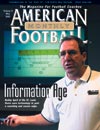AMERICAN FOOTBALL MONTHLY THE #1 RESOURCE FOR FOOTBALL COACHES
Article CategoriesAFM Magazine
|
Roll Call at the BallC.W Post’s philosophy to attack, pursue and tackle at the football stifles rushers at the point of attackby: Bryan Collins Head Coach, C.W. Post College, Brooksville, N.Y © More from this issue In order to have a great defense, you must have great pursuit and gang tackling. In order to have great pursuit, you must emphasize running to the football throughout the entire practice. This includes the time spent in our individual and team periods. You must grade the effort of your players everyday. We’ve had outstanding defenses the past few seasons. In 2000, we finished first in the nation in total defense and rushing defense and fourth in scoring defense. In 2001, we finished first in rushing defense again, giving up 211 yards in 12 games (17 yds. per game, 0.6 per carry). I think this success has been attributed to the philosophy of our defense – pursue the foot....The full article can only be seen by subscribers. Subscribe today!
|
|
|||||||
| HOME |
MAGAZINE |
SUBSCRIBE | ONLINE COLUMNISTS | COACHING VIDEOS |
Copyright 2025, AmericanFootballMonthly.com
All Rights Reserved





